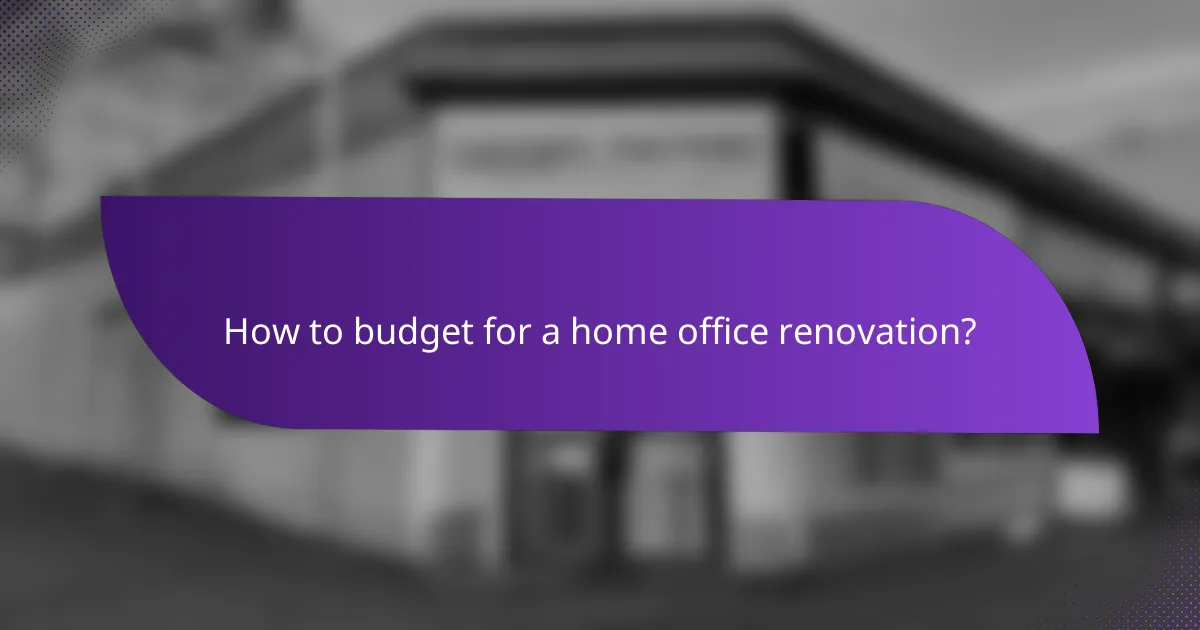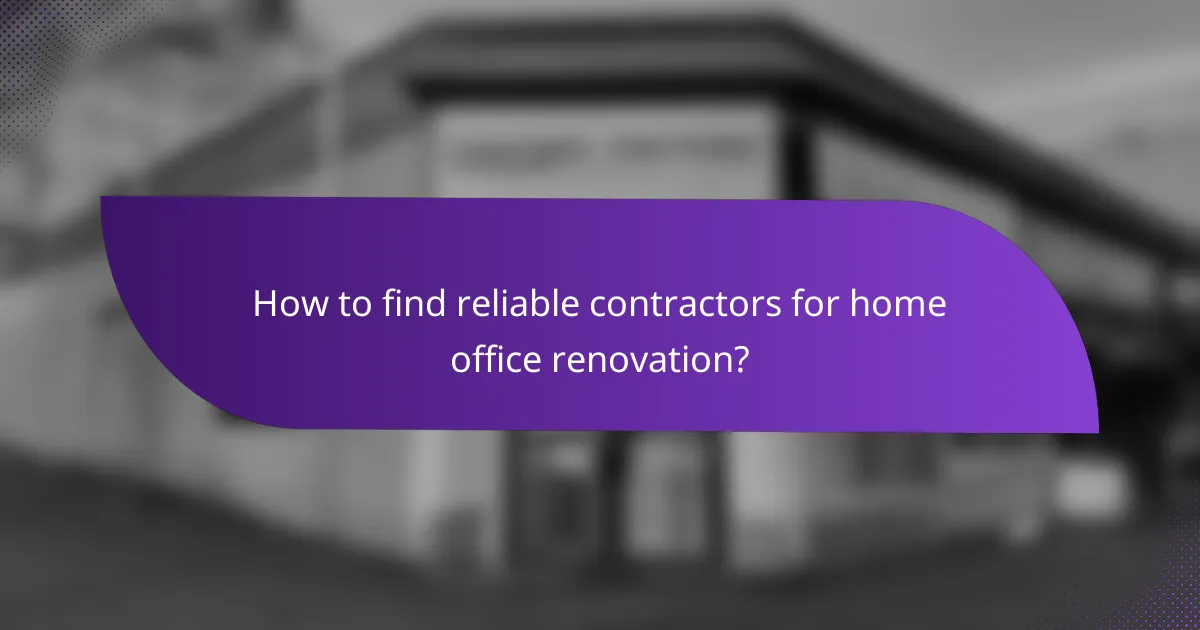Renovating a home office can be a rewarding investment, but it’s essential to understand the associated costs, which can vary widely based on equipment, design, and setup fees. Homeowners should prepare for expenses that can range from a few thousand to tens of thousands of Canadian dollars, depending on their specific needs and project scope. A well-structured budget will help ensure that funds are allocated effectively, minimizing the risk of unexpected costs.

What are the costs of home office renovation in Canada?
The costs of home office renovation in Canada can vary significantly based on equipment, design, and setup fees. Homeowners should budget for a range of expenses, typically falling within the low thousands to tens of thousands of Canadian dollars, depending on the scope of the project.
Average equipment costs
When renovating a home office, equipment costs can range from a few hundred to several thousand Canadian dollars. Essential items include a desk, ergonomic chair, computer, and peripherals like printers and monitors.
For example, a quality desk may cost between CAD 200 and CAD 1,000, while ergonomic chairs can range from CAD 150 to CAD 800. Investing in reliable technology is crucial, as it can enhance productivity and comfort.
Typical design expenses
Design expenses for a home office can vary widely, typically ranging from CAD 500 to CAD 5,000. This includes costs for hiring a designer, purchasing materials, and any custom cabinetry or shelving.
Homeowners should consider their design preferences and the overall aesthetic they want to achieve. Simple renovations may only require paint and decor, while more extensive projects could involve structural changes or high-end finishes.
Setup fees overview
Setup fees for a home office renovation often include installation costs for furniture, technology, and any necessary electrical work. These fees can range from CAD 200 to CAD 1,500, depending on the complexity of the setup.
It’s advisable to obtain quotes from multiple contractors to ensure competitive pricing. Additionally, homeowners should account for any potential permits required for electrical or structural modifications, which can add to the overall setup costs.

How to budget for a home office renovation?
Budgeting for a home office renovation involves estimating costs for equipment, design, and setup. A well-planned budget ensures you allocate funds effectively and avoid unexpected expenses.
Creating a renovation budget
Start by determining your overall budget for the home office renovation. Consider all potential expenses, including equipment, design, and any necessary construction or electrical work. A common approach is to allocate around 10-20% of your total budget for unexpected costs.
Break down your budget into categories such as furniture, technology, decor, and renovation costs. This detailed approach helps you visualize where your money will go and allows for adjustments if necessary.
Allocating funds for equipment
When allocating funds for equipment, prioritize essential items like a desk, chair, computer, and printer. Depending on quality and brand, a good office chair can range from $100 to $1,000, while desks can vary from $150 to $2,000.
Consider additional equipment like monitors, ergonomic accessories, and storage solutions. Aim to set aside about 30-50% of your total renovation budget for equipment to ensure a functional workspace.
Estimating design costs
Design costs can vary widely based on your preferences and the complexity of the project. Hiring a professional designer may cost anywhere from $50 to $200 per hour, while DIY design can save money but may require more time and effort.
Include expenses for paint, flooring, lighting, and decor in your design budget. A reasonable estimate for design elements could be around 20-30% of your total renovation budget, depending on your style choices and materials used.

What equipment is essential for a home office?
Essential equipment for a home office includes a reliable computer, ergonomic furniture, and necessary technology to ensure productivity and comfort. Investing in quality items can significantly enhance your work experience and efficiency.
Computers and accessories
A good computer is the cornerstone of any home office setup. Depending on your work requirements, you may choose between a desktop or a laptop, with prices typically ranging from a few hundred to several thousand dollars. Accessories like monitors, keyboards, and mice can further improve your setup, with ergonomic options often recommended for comfort.
Consider investing in a high-resolution monitor if you work with graphics or multiple applications simultaneously. A good quality webcam and microphone are also essential for virtual meetings, with decent models available for under $100.
Office furniture options
Choosing the right office furniture is crucial for both comfort and productivity. A sturdy desk and an ergonomic chair should be prioritized, with costs varying widely from around $150 for basic models to over $1,000 for high-end options. Look for adjustable desks that allow you to alternate between sitting and standing to promote better posture.
Storage solutions like filing cabinets or shelving units can help keep your workspace organized. Budgeting around $100 to $300 for these items can help you maintain a clutter-free environment.
Technology and software needs
Technology and software are vital for a functional home office. Basic software needs include productivity suites like Microsoft Office or Google Workspace, which can cost between $5 to $15 per month per user. Depending on your profession, you may also require specialized software, which can range from subscription-based services to one-time purchases.
Ensure you have a reliable internet connection, as this is essential for remote work. Investing in a good router may cost around $50 to $200, depending on the speed and coverage you need. Additionally, consider cybersecurity software to protect your data, which typically costs between $30 to $100 annually.

How to choose a design style for your home office?
Choosing a design style for your home office involves balancing personal preferences with functionality. Consider how the style will support your work habits and create an environment conducive to productivity.
Popular design styles in Canada
In Canada, several design styles are favored for home offices, including modern, minimalist, and rustic. Modern designs often feature clean lines and a neutral color palette, while minimalist styles emphasize simplicity and decluttered spaces. Rustic designs incorporate natural materials and warm tones, creating a cozy atmosphere.
Another popular choice is industrial style, which combines raw materials like metal and wood for a contemporary look. Each style can be tailored to reflect personal taste while ensuring a functional workspace.
Functional vs. aesthetic considerations
When designing your home office, it’s crucial to balance functional and aesthetic considerations. Functionality includes ergonomic furniture, adequate lighting, and sufficient storage solutions, which are essential for productivity. Aesthetics, on the other hand, involve color schemes, decor, and overall ambiance that make the space inviting.
Prioritize your work needs by selecting furniture that supports long hours of use, like an adjustable chair and a spacious desk. However, don’t overlook the visual appeal; incorporating personal touches, such as artwork or plants, can enhance your motivation and creativity.

What are the best practices for setting up a home office?
Setting up a home office effectively involves creating a comfortable and functional workspace tailored to your needs. Focus on ergonomics, space efficiency, and the right equipment to enhance productivity and well-being.
Ergonomic setup guidelines
To ensure an ergonomic setup, prioritize your chair and desk height. Your chair should support your lower back, and your feet should rest flat on the floor or on a footrest. The desk should allow your elbows to be at a 90-degree angle when typing.
Monitor placement is also crucial; the top of the screen should be at or just below eye level, about an arm’s length away. This reduces strain on your neck and eyes. Consider using an adjustable chair and a monitor stand to achieve the best positioning.
Maximizing space efficiency
Maximizing space efficiency in a home office involves strategic organization and furniture selection. Use vertical storage solutions like shelves to keep the floor clear and create a more open environment. Multi-functional furniture, such as desks with built-in storage, can also save space.
Consider the layout of your office; placing your desk near a window can improve natural light while keeping essential items within arm’s reach minimizes movement. Regularly declutter your workspace to maintain an organized and efficient area.

What factors influence home office renovation costs?
Home office renovation costs are influenced by various factors including location, material choices, and design complexity. Understanding these elements can help you budget effectively and make informed decisions during the renovation process.
Location-specific expenses
The cost of renovating a home office can vary significantly based on your geographical location. Urban areas often have higher labor and material costs compared to rural regions. For example, a renovation in a major city may range from $150 to $300 per square foot, while rural areas might see costs between $100 and $200 per square foot.
Additionally, local regulations and permits can add to expenses. Some municipalities require specific permits for renovations, which can incur fees ranging from $50 to several hundred dollars. Always check local regulations to avoid unexpected costs.
Material choices and their impact
The materials you select for your home office renovation can greatly affect the overall cost. High-quality materials such as hardwood flooring and custom cabinetry can elevate expenses, while more affordable options like laminate or vinyl can help keep costs down. For instance, hardwood flooring might cost between $8 and $15 per square foot, whereas laminate could be as low as $2 to $5 per square foot.
Consider the long-term value of your material choices. Investing in durable materials may lead to lower maintenance costs over time. Additionally, eco-friendly options may qualify for tax incentives or rebates, which can offset initial expenses.

How to find reliable contractors for home office renovation?
Finding reliable contractors for your home office renovation involves thorough research and careful evaluation of their credentials. Start by gathering recommendations and checking online reviews to identify trustworthy professionals in your area.
Researching local contractors
Begin your search for local contractors by asking friends, family, or colleagues for recommendations. Online platforms like Yelp or Angie’s List can provide insights into customer experiences and ratings for various contractors.
Once you have a list, check their websites for portfolios of past work, which can give you an idea of their style and expertise. It’s also beneficial to ensure they are licensed and insured, as this protects you from potential liabilities during the renovation process.
Evaluating contractor credentials
When evaluating contractor credentials, verify their licenses and insurance coverage to ensure they meet local regulations. A reputable contractor should provide proof of liability insurance and workers’ compensation to protect both their workers and your property.
Additionally, request references from previous clients and follow up with them to inquire about their experiences. Look for contractors who are willing to provide detailed estimates and timelines, as this indicates professionalism and transparency in their work approach.
